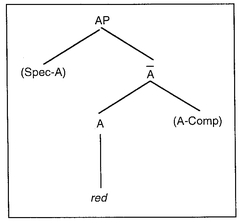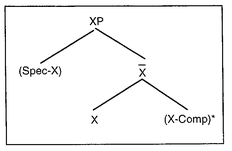APPENDIX
The Hidden Structure of Everyday Language
In Chapter 6, I said that every grammatical sentence of any human language can be constructed by the repeated application of a single rule for “putting things together,” coupled with rules for the order in which certain things go (e.g., subject before verb before object) and rules for agreement (e.g., singular/plural, gender, and tense). Whereas the rules for order and agreement vary from language to language, the basic “putting things together” rule is the same for all languages and is best expressed by means of the tree shown in
Figure A.1.
I have been calling this structure the fundamental language tree. Linguists call it the “X-bar tree,” and the theory of syntactic structure that shows how this tree can produce all grammatical sentences is called “X-bar theory.” In this appendix, I will illustrate the underlying ideas of X-bar theory (as well as explain the origin of the theory’s rather peculiar name). In particular, I will show how each of the different kinds of phrase can be built up using just the X-bar—noun phrases, verb phrases, adjectival phrases, prepositional phrases, even sentences themselves. Although they may appear to fit together in different ways, in reality they all have the same basic structure. That structure involves three parts.
FIGURE A.1 The Fundamental Language Tree: The Generic Structure for X-bar Theory
First, every phrase has what is called a head. The head is the only constituent of a phrase that has to be present; the two other constituents are optional. The head cannot be longer than a single word. (It can be less, as we shall see.) The head of a noun phrase must be a noun; the head of a verb phrase must be a verb or a part of a verb; the head of an adjectival phrase must be an adjective. The head exercises considerable control over the clause.
The head of a phrase is linked first to its
complement, if it has one. For example, in the noun phrase
the house with the red door, the head is the noun
house and its complement is the prepositional phrase
with the red door. Together, the noun (N) and the prepositional phrase (PP) that is its complement (N-Comp) form what is known as the N-bar,
house with the red door. The terminology “N-bar” stems from the notation generally used to denote this construction: an N with a bar over it, as shown in
Figure A.2. To complete the noun phrase (NP), the N-bar is then combined with the
specifier (Spec-N)
the. This construction is shown in
Figure A.2. (The triangle beneath the node PP in
Figure A.2 is a standard way to indicate that this is itself a phrase that requires further analysis. The triangle is intended to suggest a further parse tree.)

Likewise, the prepositional phrase
with the red door has its own phrase structure tree, illustrated in
Figure A.3. The head of this phrase is the preposition
with. Notice that for this phrase, there is no specifier. This is indicated by putting parentheses around the label Spec-P (as well as by there being no entry beneath the label).
FIGURE A.4 Construction of the Noun Phrase
the red door
Figure A.4 illustrates the next step in the analysis, the structure of the noun phrase
the red door.
Notice that, since any complement has to be a phrase, the N-Comp red is considered an adjectival phrase, not a word. This means that another step is required to complete the analysis: the phrase structure for the AP red, given in
Figure A.5. (This is why there is a triangle beneath the AP node in
Figure A.4.)
Notice that by consistently drawing my trees with the specifier to the left, then the head, then the complement, I have drawn the phrase structure tree for the red door so that the horizontal ordering of the tree (which, you will recall, is not a structural feature of the tree) differs from the ordering of the words in English. (It does, however, agree with the ordering in French: la porte rouge.)
I should perhaps stress that I was not being overly pedantic in insisting that the role played by the complement red in the noun-phrase the red door is that of an adjectival phrase, not a word. When describing a mechanism for putting linguistic units into boxes to give larger linguistic units (which may themselves be put into still-larger boxes), we are looking for a simple mechanism that works in all cases. The approach that linguists have taken is to regard any phrase as made up of a head—which is no longer than a single word—an optional complementary phrase, and an optional specifier. This means that we occasionally have to put a single word into a box.
FIGURE A.5 Construction of the Adjectival Phrase red
Actually, we allow a head to be combined with more than one complementary phrase, as occurs with the noun phrase
the house with the red door where Sally lives. Figure A.6 gives the parse tree for that phrase. Each complement is itself a phrase (i.e., a box).
Figure A.7 shows the general combinatory structure for constructing phrases. In that diagram, we use the letter X as a sort of variable, to stand for any N (noun), V (verb), P (preposition), A (adjectival/adverbial), etc. The parentheses indicate an optional item. The asterisk indicates an item that can be repeated (in principle, any finite number of times; in prac- tice
, generally just once or twice). Because the key step is the combination of the head X and the complement phrase (or phrases) X-Comp to give the unit whose label is read aloud as “X-bar,” the theory of phrase structure that I have just outlined is known among linguists as “X-bar theory.”
FIGURE A.6 Structure of a Noun Phrase with Two Complements
The phrase structure trees of X-bar theory clearly indicate the possible interpretations of an ambiguous phrase. For example, the two possible readings of the phrase
the house with the red door that Max likes are illustrated in
Figure A.8. In the first reading (top), Max likes the house; in the second reading (bottom), he likes the door. In both examples, the analysis is incomplete; each of the complement phrases on the bottom line requires further “unpacking.”
FIGURE A.8 Disambiguation of an Ambiguous Noun Phrase
Figure A.9 gives an example of a verb phrase,
run into the room. Again, we see the familiar X-bar combination of the head of the phrase (in this case, an untensed verb), a verb complement (in this case, a prepositional phrase), and no specifier.
Other kinds of phrase are handled similarly. But what about an entire sentence or clause? Isn’t that also a phrase (or possibly a logical combination of phrases, connected together by and, or, if... then, unless, etc.)?
Let’s start with a simple example: John ran into the room. If this is to fit our pattern of phrase structure, it must have a head. But what is that head? It can’t be John. John is a noun, and only noun phrases have nouns as heads. Nor can it be ran, since ran is a (cased, tensed) verb, and only verb phrases have verbs as heads.
The answer is to be found in the very nature of a sentence. Sentences are the whole units where the various parts come together to give informational content—a claim about the world in the case of a declarative sentence, a request in the case of an interrogative, etc. In order to provide informational content, a sentence must specify the tense of the main verb. And that tense is the head. Or rather, tense is part of the head. The verb must also have a case, which must agree with the subject of the sentence, and that too is part of the head of the sentence. The tree for our example
John ran into the room is given in
Figure A.10.

Since the tense and case of many verbs is provided by an inflection to the verb, it is common to use the letter I (or sometimes the abbreviation INFL) for the head, as I have done. The subject of the sentence, necessarily a noun phrase, is then the specifier for I, Spec-I (in our example, the NP John). The I-Comp is the untensed, uncased verb phrase (run into the room in our example). The tensed, cased verb phrase (in our example, ran into the room) is then the I-bar combination. The entire sentence, S, could also be denoted as IP, the inflection phrase.
It is particularly important to recognize that the verb phrase run into the room is not tensed or cased. The tense and case of the main verb in a sentence is provided by the head. This view of a sentence puts considerable emphasis on the tense and case of the main verb. As I have mentioned, the head of any phrase has a governing role over the remainder of the phrase. But this is exactly what happens with the tense and case of the main verb in a sentence. Tense reaches into the main verb phrase (the I-complement), generally causing an inflection to the main verb, while case reaches across to the subject (the I-specifier), ensuring agreement between the subject and the main verb.

This example illustrates how sentences may be constructed using the same combinatorial machinery that gives all other phrases. This is a desirable feature both for scientific parsimony and for helping us understand how Homo sapiens could have acquired syntax in the first place. If it seems odd to think of a sentence in this way, part of the reason may be that this is the first example we have encountered where the head is not a word. I could have avoided this by taking a slightly different example: John did run into the room. Now the head is a clearly identifiable word, did. Of course, did still carries tense and case, which govern the rest of the sentence just as before. In this case, INFL has a word of its own.
FIGURE A.11 ASentence with an Unarticulated Constituent
In fact, there are other examples where an important constituent of a phrase is not explicit. For example, the sentence
Mary expected to arrive late has the phrase structure illustrated in
Figure A.11.
The person that Mary expected to arrive late was obviously Mary herself. The sentence has an unarticulated constituent in the position denoted by the letter
e in the following, linguist’s version of the original sentence:
Mary expected e
to arrive late. As shown in
Figure A.11, the unarticulated constituent
e, which denotes Mary, plays a role in the grammatical structure of the sentence. The constituent e continues to play a role as we further analyze the verb phrase
expect e
to arrive late.










